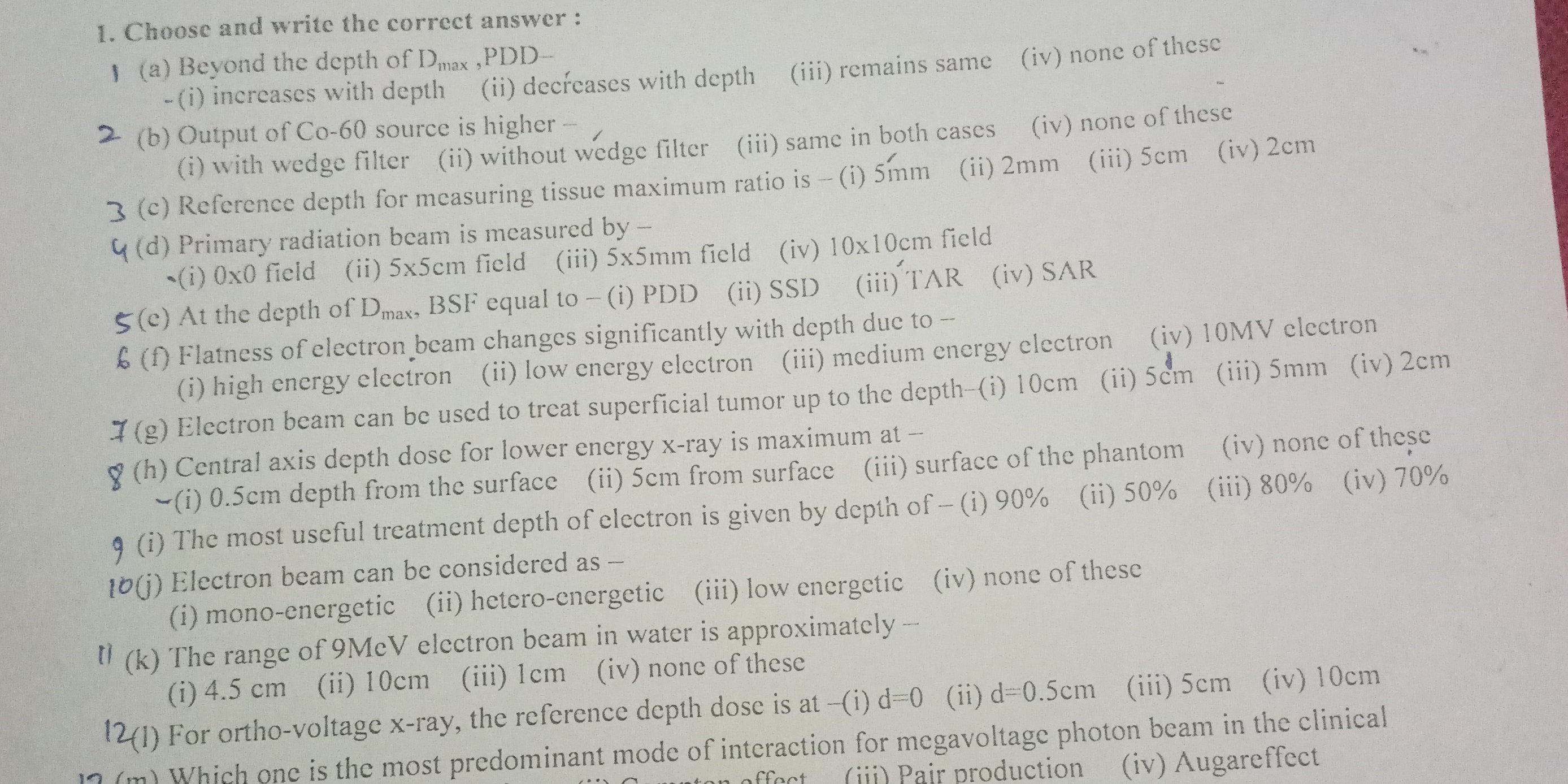1. Choose and write the correct answer: 1. (a) Beyond the depth of Dmax, PDD - (i) increases with depth (ii) decreases with depth (iii) remains same (iv) none of these 2. (b) Outpu... 1. Choose and write the correct answer: 1. (a) Beyond the depth of Dmax, PDD - (i) increases with depth (ii) decreases with depth (iii) remains same (iv) none of these 2. (b) Output of Co-60 source is higher - (i) with wedge filter (ii) without wedge filter (iii) same in both cases (iv) none of these 3. (c) Reference depth for measuring tissue maximum ratio is - (i) 5x5 cm field (ii) 5x5 mm field (iii) 10x10 cm field 4. (d) Primary radiation beam is measured to - (i) PDD (ii) SSD (iii) TAR (iv) none of these 5. (e) At the depth of Dmax, BSF equal to - (i) PDD (ii) SSD (iii) TAR (iv) none of these 6. (f) Flatness of electron beam changes significantly with depth due to - (i) high energy electron (ii) low energy electron (iii) medium energy electron (iv) 10MV electron 7. (g) Electron beam can be used to treat superficial tumor up to the depth - (i) 0.5 cm (ii) 5 cm (iii) 5 mm (iv) 2 cm 8. (h) Central axis depth dose for lower energy x-ray is maximum at - (i) 0.5 cm depth from the surface (ii) 5 cm from surface (iii) surface of the phantom (iv) none of these 9. (i) The most useful treatment considered as - (i) mono-energetic (ii) hetero-energetic (iii) low energetic (iv) none of these 10. (j) Electron beam can be considered as - (i) mono-energetic (ii) hetero-energetic (iii) low energetic (iv) none of these 11. (k) The range of 9MeV electron beam in water is approximately - (i) 4.5 cm (ii) 10 cm (iii) 5 cm (iv) none of these 12. (l) For ortho-voltage x-ray, the reference depth dose is at - (i) d=0 (ii) d=0.5 cm (iii) 5 cm (iv) 10 cm 13. (m) Which one is the most predominant mode of interaction for megavoltage photon beam in the clinical situation? (i) Photoelectric effect (ii) Pair production (iii) Augereffect

Understand the Problem
The question is a multiple-choice format quiz related to topics likely in radiation physics or medical physics, specifically dealing with concepts such as radiation depth, electron beams, and measurement techniques. The user is expected to select the correct answer from a set of options provided for each question.
Answer
(a) ii, (b) ii, (c) iii, (d) iii, (e) iii, (f) ii, (g) iv, (h) iii, (i) ii, (j) ii, (k) i, (l) ii, (m) ii.
The final answer is: (a) ii, (b) ii, (c) iii, (d) iii, (e) iii, (f) ii, (g) iv, (h) iii, (i) ii, (j) ii, (k) i, (l) ii, (m) ii.
Answer for screen readers
The final answer is: (a) ii, (b) ii, (c) iii, (d) iii, (e) iii, (f) ii, (g) iv, (h) iii, (i) ii, (j) ii, (k) i, (l) ii, (m) ii.
More Information
These answers cover key aspects of radiation therapy, including changes in depth dose and interactions of different beams and energies.
Tips
A common mistake is not considering the energy or type of beam when determining effects at different depths.
Sources
- Radiation Therapy - medicalphysics.org
AI-generated content may contain errors. Please verify critical information